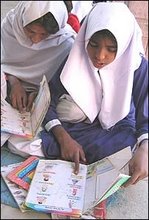PREFACE: Every gun that is made, every warship launched, every rocket fired signifies, in the final sense, a theft from those who hunger and are not fed, those who are cold and are not clothed. The world in arms is not spending money alone. It is spending the sweat of its laborers, the genius of its scientists, the hopes of its children… This is not a way of life at all, in any true sense. Under the cloud of threatening war, it is humanity hanging from a cross of iron.
— Former U.S. President, Dwight D. Eisenhower, in a speech on April 16, 1953
To find out who shares responsibility for global militarization, follow the money trail. Regardless of attempts to legitimize the trade, the historical reality is that bribery, corruption and mercenary as well as national self-interest lie at the heart of the trade. This month’s blog highlights the mainstream facts and some relevant reference sources.
WORLD MILITARY EXPENDITURES: World military expenditure in 2006 was estimated at $1204 billion in current prices, an increase of 3.5% in real terms since 2005 and of 37% over the 10-year period since 1997. Average spending per capita increased from $173 in 2005 to $177 in 2006 at constant (2005) prices and exchange rates and to $184 at current prices. The USA is responsible for 46% of the world total, distantly followed by the UK, France, Japan and China with 4-5% each.
USA: The rapid increase in the United States' military spending is to a large extent due to continued costly military operations in Iraq and Afghanistan. Between September 2001 and June 2006, the US Government provided a total of $432 billion in annual and supplemental appropriations under the heading 'global war on terrorism'. This massive increase in US military spending has been one of the factors contributing to the deterioration of the US economy since 2001. In addition to its direct impact of high military expenditure, there are also indirect and more long-term effects. According to one study taking these factors into account, the overall past and future costs until year 2016 to the USA for the war in Iraq have been estimated to $2267 billion.
CHINA: In 2006 China continued its steep increase in military expenditure, for the first time surpassing that of Japan and hence replacing Japan as the country in Asia with the highest level of military expenditure and as the fourth biggest spender in the world. Amid intense discussions on the right level of Japanese military spending, Japan decided, for the fifth consecutive year, to reduce its military spending in 2006 while at the same time focusing its military budget on missile defence.
THE GLOBAL MARKET FOR ARMS: Aside from spending on their own military “needs”, it is fairly obvious from the figures quoted below that the leading arms dealing countries in the world are reaping major economic gains from exporting their military technologies. The only G-8 country not ranking highly on arms exporting is Japan.
Sellers: During the period 2000-2006, the US sold $45.4 billion worth of armaments into the global marketplace, ahead of Russia at $40.5 billion, followed by Germany at $11.6 billion and France at $11.1 billion. This was followed by the UK (7.0), the Netherlands (3.7), Sweden (3.1), Italy (3.0), China (2.9) with Ukraine (2.5) completing the top ten. Israel and Canada came in at 2.3B and 1.3 respectively.
Buyers: A comparison of government spending priorities across samples of countries in different per capita income groups shows that the lower the income group, the higher the priority given to military spending in relation to social spending. For example, UN data sources show that military expenditures exceed public expenditures on health or education for almost every country in South Asia (exception: the Maldives). Developing nations continue to be the primary focus of foreign arms sales activity by weapons suppliers.[2] During the years 1996-2003, the value of arms transfer agreements with developing nations comprised 63.9% of all such agreements worldwide. More recently, arms transfer agreements with developing nations constituted 60.4% of all such agreements globally from 2000-2003, and 53.6% of these agreements in 2003. The top seven recipient countries, comprising 59% of all purchases from 1999-2006, are: India 11%, China 8%, Saudi Arabia 8%, Egypt 6%, UAE 6%, Israel 5% and Pakistan 5%.[3]
References:
1. Stockholm International Peace Research Institute. http://www.sipri.org/contents/milap/milex/mex_trends.html Accessed April 24, 2008.
2. Goliath Business Knowledge on Demand. Conventional Arms Transfers to Developing Nations. http://goliath.ecnext.com/coms2/gi_0199-4561391/Conventional-Arms-Transfers-to-developing.html Accessed April 25, 2008.
3. Anup Shah. Arms Trade – a Major cause of Suffering. October 30, 2007. http://www.globalissues.org/Geopolitics/ArmsTrade/BigBusiness.asp
COMMENTARY
There is clear evidence that the international transfer of arms or the training of foreign security forces can provide repressive governments and abusive armed groups with the means to carry out or intensify gross human rights violations. Arms brokers have been at the center of many of the most disturbing arms deals, including weapons transfers to abusive armed groups and countries under U.N. arms embargoes.[1] From 1998 to 2001, the USA, the UK, and France earned more income from arms sales to developing countries than they gave in aid.
The arms industry is unlike any other. It operates without regulation. It suffers from widespread corruption and bribes. And it makes its profits on the back of machines designed to kill and maim human beings. So who profits most from this murderous trade? The five permanent members of the UN Security Council—the USA, UK, France, Russia, and China. Together, they are responsible for eighty eight per cent of reported conventional arms exports. “We can’t have it both ways. We can’t be both the world’s leading champion of peace and the world’s leading supplier of arms.” Former US President Jimmy Carter, presidential campaign, 1976
References:
1. Amnesty International USA. http://www.amnestyusa.org/our-priorities/arms-trade/page.do?id=1011003&n1=3&n2=24 Accessed April 25, 2008.
2. The Arms Industry. Control Arms Campaign, October 2003. http://www.controlarms.org/the_issues/arms_industry.htm Accessed April 25, 2008.
RECOMMENDED SITE: We close this brief review with reference to a specialized website that we believe lays out the facts in a much more comprehensive manner than we have done:
Reference: Anup Shah. Arms Trade – a Major cause of Suffering. October 30, 2007. http://www.globalissues.org/Geopolitics/ArmsTrade/BigBusiness.asp
FROM a Great Canadian and World Statesman
"A great gulf... has... opened between man's material advance and his social and moral progress, a gulf in which he may one day be lost if it is not closed or narrowed..."
Lester B Pearson
http://nobelprize.org/nobel_prizes/peace/laureates/1957/pearson-lecture.html
INSPIRATIONAL WELCOME ............................... from T.S.Eliot's "Little Gidding"
If you came this way From the place you would come from... It would be the same at the end of the journey...
If you came, not knowing what you came for, It would be the same... And what you thought you came for Is only a shell, a husk of meaning... From which the purpose breaks only when it is fulfilled If at all.


























